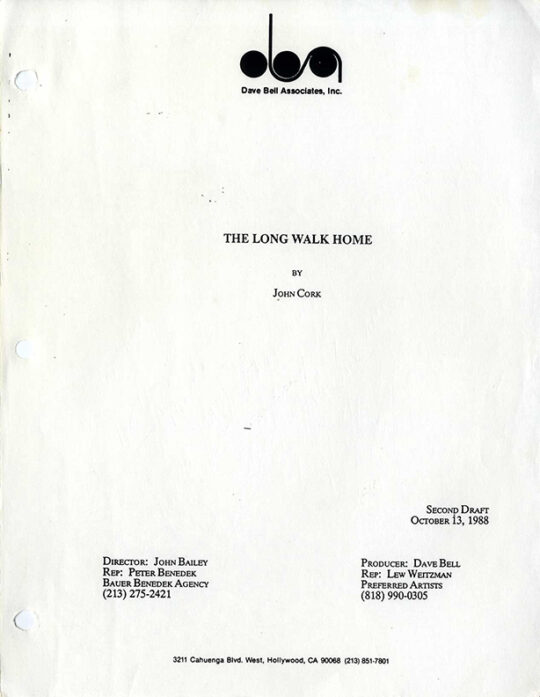DIRTY HARRY [ca. 1970] Early draft film script by Harry Julian Fink, Rita M. Fink
Los Angeles: FCA Agency, [ca. 1970]. Vintage original film script. Mimeograph, brad bound, 112 pp. Plain stiff wrappers with typed label affixed to front wrapper. Minor wear to blank exterior of label, overall fine.
Dirty Harry remains a classic of 1970s American filmmaking and one of the classic crime films ever made.
This undated screenplay draft by Harry Julian Fink and Rita M. Fink, who also devised the story, was substantially revised prior to shooting. Dean Reisner is credited on-screen as a co-writer. John Milius (Apocalypse Now) was also employed uncredited as a script doctor and claims to be responsible, among other things, for the “cop being the same as the killer except he has a badge”. And also for the notion of the avenging cop as a loner.
The most significant difference between this draft and the completed film is its setting. The Fink screenplay is set in New York City. The Siegel film takes place in San Francisco, makes splendid use of numerous San Francisco landmarks, and positions the city itself as an embodiment of the hippie decadence that opposes cop Harry at every turn. The ultimate embodiment of that decadence is the story’s psychotic villain, a serial killer named Scorpio.
However, in the Fink draft he is not named Scorpio, referred to only as the Sniper or the Killer. Moreover, in the Fink draft he is a middle-aged ex-con, not the young deranged hippie with the peace-sign belt buckle portrayed so brilliantly by Andy Robinson in the Siegel film (the name Scorpio is meant to remind viewers of San Francisco’s infamous Zodiac killer). The character of Harry is also somewhat different from his portrayal by Clint Eastwood in the Siegel film. In the Fink draft, Harry is a shabby, middle-aged, cigar-smoking, hot dog-chomping New Yorker, a character more suitably portrayed by someone like Frank Sinatra who was, in fact, the producers’ first choice for the role.
The first two-thirds of the Fink screenplay hits most of the same narrative beats as the Siegel film. It begins with the sniper shooting his first victim. We then get the scene where cop Harry interrupts his lunch mid-way through to foil a bank robbery across the street, shooting the robbers and concluding the sequence with what would later become the movie’s most famous catchphrase, “this is a .44 Magnum and will blow your head into little bitty pieces . . . . are you feeling lucky, punk?”
Harry is assigned a younger Latino partner named Chico. In the Fink screenplay, but not the film, Harry recognizes Chico as someone he once arrested for juvenile delinquency. In the movie, Chico is college educated, has a teaching credential and quits the force for the sake of his marriage after being wounded in a battle with the sniper.
In both the Fink screenplay and the Siegel film, Harry talks a “jumper” off a building ledge (that’s why they call him Dirty Harry — because he gets all the dirty jobs). In both the Fink screenplay and the Siegel film, the sniper abducts a young woman, buries her alive and demands ransom from the City to reveal her location. Harry is chosen to deliver the ransom money, manages to overcome the sniper, and essentially tortures him to reveal the girl’s location — which results in the sniper’s conviction being tossed out of court due to the violation of his rights.
The other major difference between the Fink screenplay and the Siegel film is the way they conclude. In the Fink screenplay, the sniper takes some school children hostage, demands a plane to take him out of the country, and the script ends with a Western-style shootout between Harry and the sniper on the airport’s tarmac. In the Siegel film’s last act, the sniper abducts a childrens’ school bus, Harry single-handedly (without the approval of the San Francisco bureaucracy) intercepts the bus, pursues the sniper off the bus, and the film ends, unlike the screenplay, with a repetition of Harry’s catchphrase, “Do you feel lucky, punk?” Only the crazed sniper, unlike the bank robber in act one, is not so lucky. After which Siegel’s Harry, unlike the Harry in the Fink screenplay, throws away his badge.
Out of stock
Related products
-

(African American film) A PIECE OF THE ACTION [working title: SOMETHING BIG COMING UP] (Nov 1, 1976) Film script
$750.00 Add to cart -

Sidney Lumet (director) PRINCE OF THE CITY (Jan 1980) Final Draft film script
$950.00 Add to cart -

CROSS CREEK (Feb 9, 1982) Rev Final Shooting script by Dalene Young
$750.00 Add to cart -

LONG WALK HOME, THE (Oct 13, 1988) Second draft film script by John Cork
$375.00 Add to cart

![DIRTY HARRY [ca. 1970] Early draft film script by Harry Julian Fink, Rita M. Fink](https://www.walterfilm.com/wp-content/uploads/2024/11/DirtyHarrySCR_a.jpg)
![DIRTY HARRY [ca. 1970] Early draft film script by Harry Julian Fink, Rita M. Fink - Image 2](https://www.walterfilm.com/wp-content/uploads/2024/11/DirtyHarrySCR_b.jpg)
![DIRTY HARRY [ca. 1970] Early draft film script by Harry Julian Fink, Rita M. Fink - Image 3](https://www.walterfilm.com/wp-content/uploads/2024/11/DirtyHarrySCR_c.jpg)